17 Types of Customers and How to Deal with Them
Treating all customers the same is a major mistake—each customer type is vastly different and requires a tailored approach.
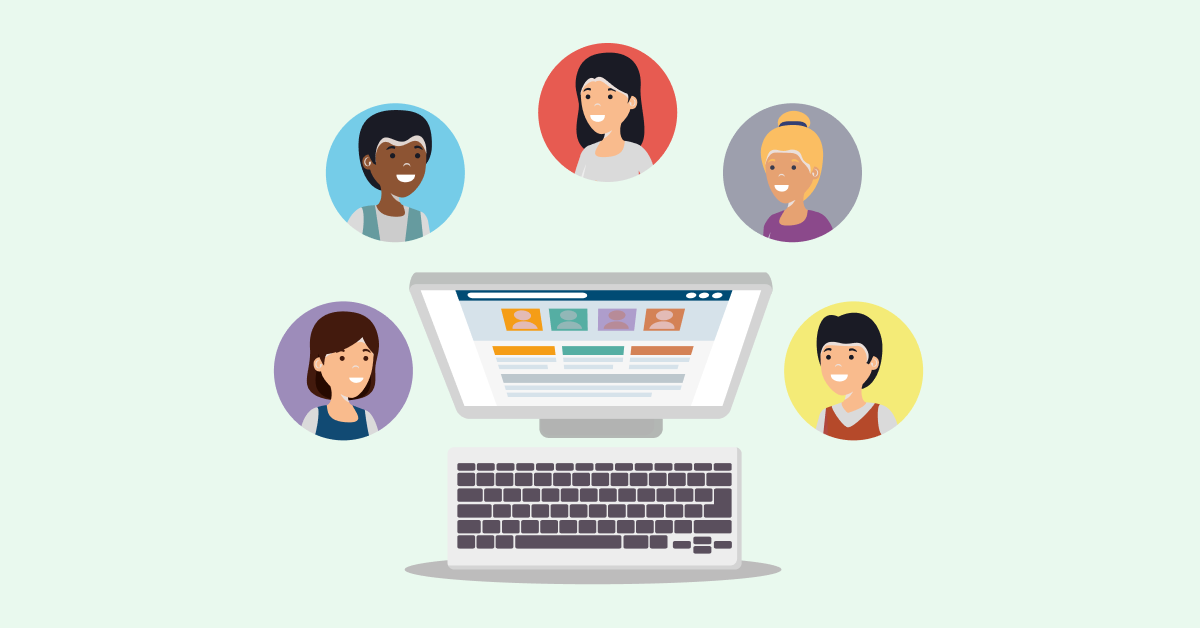
Customers are the key to success. They come with various preferences, which can greatly influence their purchasing decisions and overall satisfaction. Studies show that 33% of customers leave a brand just after one bad experience!!
Each customer group has its own distinct characteristics and buying patterns. Understanding the different types of customers can provide valuable insights into their behavior and help you tailor your approach to meet their needs.
Let’s explore the various types of customers and how businesses can effectively cater to their specific needs to drive customer satisfaction.
A customer is defined as an individual or entity that buys goods and services from a business. They are the end-users who engage with a company to fulfill their needs. Customers have different personalities and are spread across the various stages of your sales funnel.
Customers can range from individual consumers who make personal purchases to businesses that procure products or services for their operations. Customers can be individuals, businesses, or even other organizations, depending on the nature of the business.
Key objectives:
Customers are the life-blood of every business. Your entire business revolves around your customers so understanding all types of different customers is a mandate to sustain.
It is crucial for personalizing your marketing strategies, improving customer satisfaction and maximizing sales opportunities. Here are quick steps to identify your customer base.
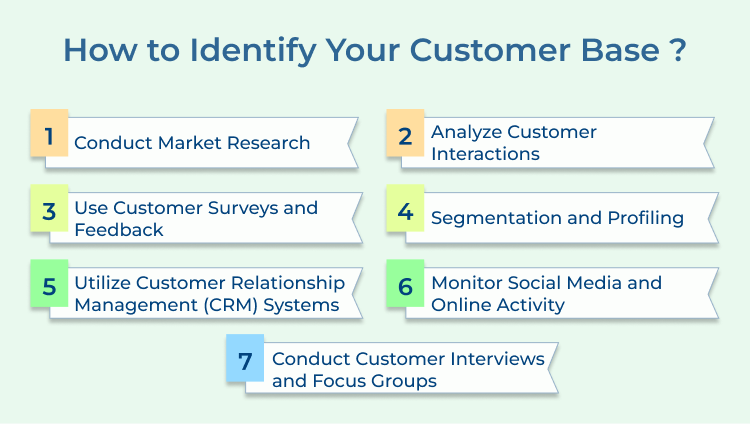
Market research involves gathering and analyzing information about potential customers, competitors, industry trends, etc. Use demographic data, industry reports, and competitor analysis to understand who’s buying products similar to yours. Both primary research (interviews, focus groups) and secondary research (published reports) provide valuable insights into customer behaviors as well as preferences.
Always remember to analyze customer interactions across various touchpoints, including in-store visits, website browsing behavior, social media engagement and customer service inquiries. You can look for recurring themes, questions and preferences expressed by customers to gain insights into their needs or preferences.
Develop targeted surveys to collect direct feedback from existing and potential customers about their needs, preferences, pain points, etc. Analyze customer reviews, support tickets, and sales interactions to identify patterns. This firsthand information reveals what customers value most about your products or services and highlights areas for improvement.
It involves demographic segmentation (age, gender, location), psychographic segmentation (lifestyle, values, interests) or behavioral segmentation (purchase frequency, product usage). You can create detailed customer profiles for each segment to better understand their motivations and needs.
CRM systems centralizes customer data, allowing you to track interactions, purchase history, and communication preferences. Analyze this information to identify your most valuable customers, recognize buying patterns, and segment customers based on various criteria. Advanced CRM analytics can help predict future purchasing behavior and identify upselling opportunities.
Track mentions of your brand, products, and relevant industry keywords across social platforms. Analyze which content resonates with your audience and drives engagement. Social listening tools can reveal demographic information, sentiment analysis, and conversation trends. Website analytics provide insights into visitor behavior, traffic sources, and content preferences.
In this stage, you can arrange comprehensive customer interviews and focus groups to gain qualitative insights into customer attitudes, motivations, pain points, etc. Ask open-ended questions to encourage discussion and uncover valuable insights that may not be captured through quantitative data alone.
Understanding the different types of customers is essential for any business that wants to effectively market its products. Here’s how to categorize and deal with them:
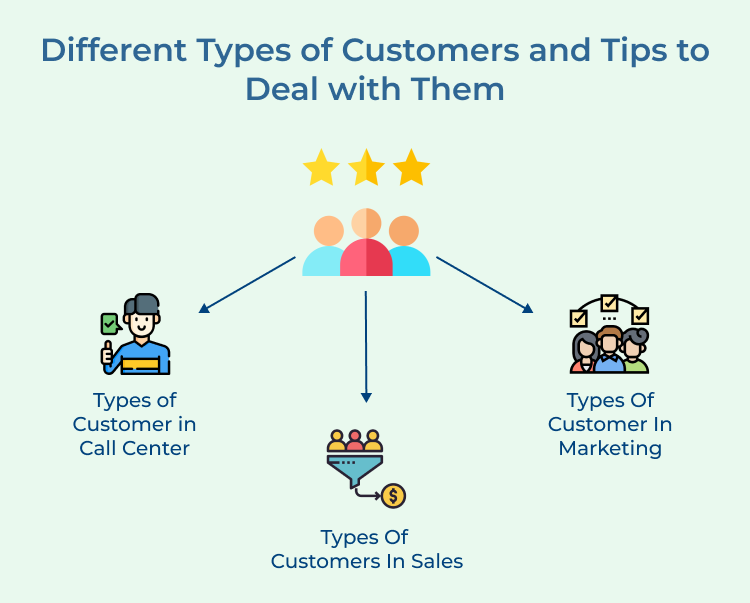
Knowing the different types of customers that call center agents may encounter can help them better handle various situations and provide effective customer service.
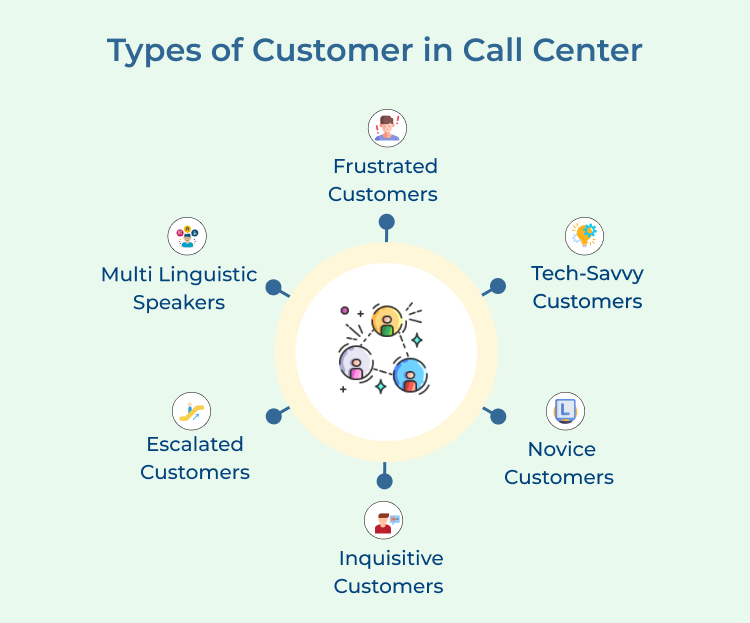
The frustrated customer is one who is annoyed because of a problem he experiences with the product/service purchased and then contacts the call center.
These types of customers may be upset and dealing with frustrated customers requires patience, active listening, empathy etc. Agents must address their concerns promptly and work towards finding an effective solution.
Here are some pro tips to follow:
The tech-savvy customer is well-versed in using technology and may have a deep understanding of the product/service they are contacting the call center about.
They are usually efficient and require more technical information or troubleshooting assistance. Call center agents should be well-equipped with product knowledge and be able to provide technical support for these customers.
Here are some pro tips to follow:
Unlike the tech-savvy customer, the novice customer is less experienced and might be using your product or service for the first time.
Novice customers require clear explanations and a lot of patience. They are potential clients who may turn into loyal customers if their initial experience is positive.
Here are some pro tips to follow:
The inquisitive customer often contacts the call center to make inquiries and gather information. These types of customers may have questions about the product features, pricing, or any other specific details.
Call center agents should be knowledgeable enough and able to provide accurate information to satisfy their curiosity.
Here are some pro tips to follow:
Escalated customers are those who have reached out to the customer service team before but are still unsatisfied with the resolution. These types of customers may be more demanding, assertive or even angry.
Handling escalated customers requires extra attention and problem-solving skills. It’s important to listen actively, acknowledge their concerns and offer appropriate solutions to regain their trust.
Here are some pro tips to follow:
Call centers often cater to customers who speak different languages. Agents who are fluent in multiple languages can assist customers who prefer to communicate in their native tongue.
Employing multilingual agents or providing translation services can be beneficial in these situations. It not only helps in understanding the customer’s needs better but also creates a more positive customer experience.
Here are some pro tips to follow:
Sales customers are individuals or businesses who are interested in purchasing your product or service. Understanding the different types of sales customers can help you customize your sales approach to meet their needs.
Some common types of sales customers include:
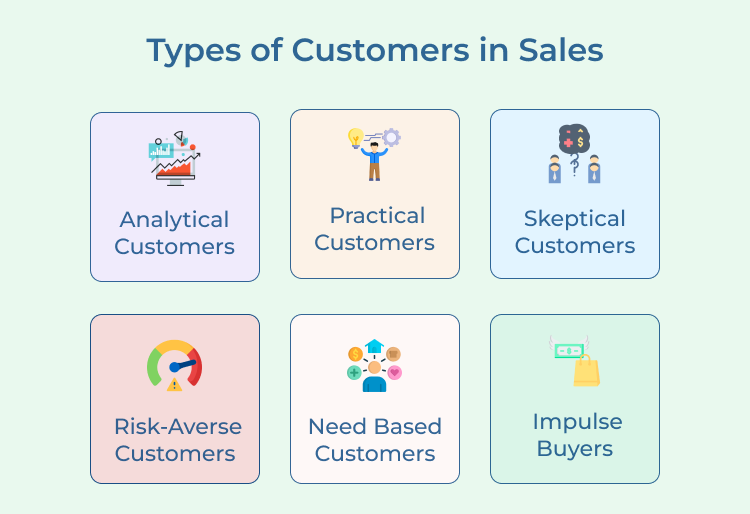
Analytical customers are meticulous and detail-oriented. They demand evidence and thorough information before making a purchase.
These types of customers rely heavily on data, statistics and facts to support their decision-making process. It is crucial to provide them with in-depth product information, comparisons, testimonials etc. to win their trust and convince them of the value your product offers.
Here are some pro tips to follow:
Practical customers prioritize functionality, utility, and efficiency. They are interested in products or services that can solve their problems or make their lives easier without unnecessary frills.
Presenting practical customers with clear benefits, cost-effectiveness and practical applications of your product is key to appealing to their needs.
Here are some pro tips to follow:
Skeptical customers approach the sales process with caution. They may have had negative experiences in the past or have difficulty trusting salespeople.
Building trust is crucial when dealing with skeptical customers. Showcasing real-life success stories and providing transparent as well as honest information can help establish credibility.
Here are some pro tips to follow:
Risk-averse customers are afraid of making the wrong decision or losing their investment. They tend to hesitate or procrastinate before committing to a purchase.
Mitigating their fear by offering money-back guarantees, warranties or testimonials from satisfied customers can help ease their concerns and provide them with the confidence they need to move forward.
Here are some pro tips to follow:
These customers have an immediate and specific need that requires a solution. They are actively searching for a product or service that can fulfill their requirements.
Recognizing the sense of urgency and positioning your product as the ideal solution can greatly enhance your chances of making a sale. Quick response times, clear value propositions and excellent customer service are crucial when catering to need-based customers.
Here are some pro tips to follow:
Impulse buyers are spontaneous and often act on emotion rather than rationality. They may make purchases based on attractive promotions, eye-catching displays or peer influence. To capture their attention, create engaging, visually appealing marketing materials, highlight the instant gratification and pleasure that your product can deliver.
Here are some pro tips to follow:
Understanding the different types of marketing customers can help you create targeted and effective marketing strategies.
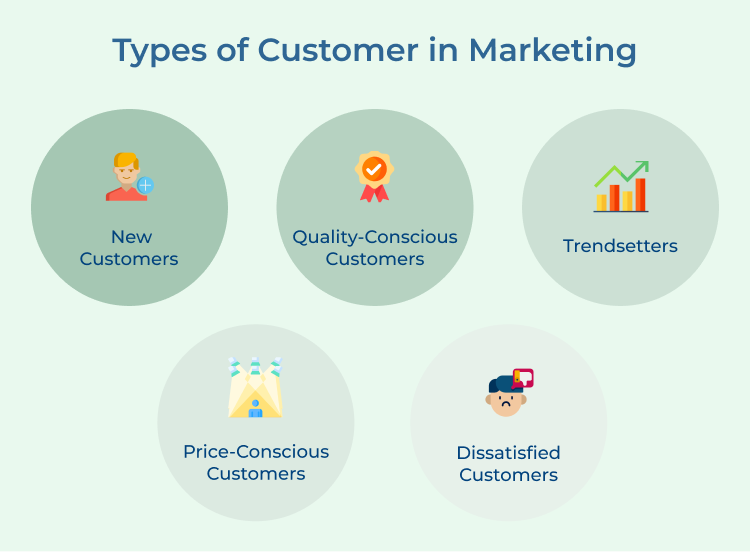
New customers are those who have recently discovered your brand or product and have made their first purchase. They are typically looking for information, trying to understand the benefits of your offering and evaluating whether it meets their needs.
Here are some pro tips to follow:
Quality-conscious customers prioritize the quality and reliability of products or services over other factors such as price or brand reputation. They are willing to pay a premium for high-quality offerings and may conduct thorough research before making a purchase.
Here are some pro tips to follow:
These types of customers always want to be ahead of the curve. They seek out innovative and cutting-edge products or services. They also are often the first to try new things.
Trendsetters can be influential in spreading the word about your brand, so targeting them can help generate buzz and attract a broader customer base.
Here are some pro tips to follow:
Price-conscious customers prioritize affordability and are always on the lookout for the best deals or discounts. To attract and retain these customers, it is important to emphasize competitive pricing, promotions, value for money, etc.
Here are some pro tips to follow:
Dissatisfied customers are those who have had a negative experience with your brand or product. Handling customer complaints and resolving issues promptly is critical in retaining dissatisfied customers.
Addressing their concerns providing exceptional customer support can help turn a negative experience into a positive one.
Here are some pro tips to follow:
Providing exceptional customer support is crucial for building and maintaining strong relationships with your clients. But, in order to provide exceptional support, you need to know your customers inside and out. Backed with customer behavior analytics, you can tailor your support strategies and deliver a personalized experience that promotes long-lasting customer relationships.
You can create a customer-centric support experience that sets you apart from the competition by conducting market research, creating buyer personas. Exceptional support starts with understanding your customers.
1. How can businesses analyze and understand the needs of different types of customers?
Businesses can employ various methods to analyze and understand the needs of different types of customers . One common approach is conducting customer surveys, interviews or focus groups to gather information about their preferences, challenges and expectations. Social media analytics and online reviews are also valuable tools to gauge customer sentiments.
2. What are the specific needs of customers?
The specific needs of customers can vary greatly depending on their demographics, preferences, and goals. Some customers might prioritize affordability, while others may prioritize quality or convenience. Understanding these specific needs allows businesses to tailor their marketing strategies, product development and customer service to cater to different customer segments effectively.
3. Why does every customer need to be treated differently?
Customers have unique preferences, expectations, and motivations. Treating every customer the same way may result in missing out on opportunities to better serve their individual needs. By treating each customer differently, businesses can provide personalized experiences and address their specific concerns, leading to higher customer satisfaction, loyalty, increased sales etc.
4. What is the best way to identify customer types for your business?
Identifying customer types begins with market research. By collecting data on customer demographics, buying habits and preferences, businesses can segment their customer base into different categories. The segmentation can be based on factors such as age, gender, location, interests, or purchasing power.